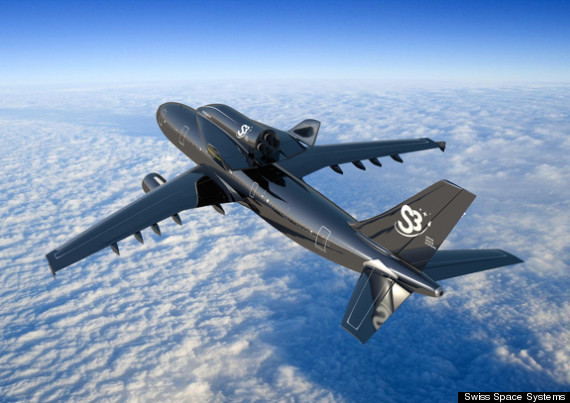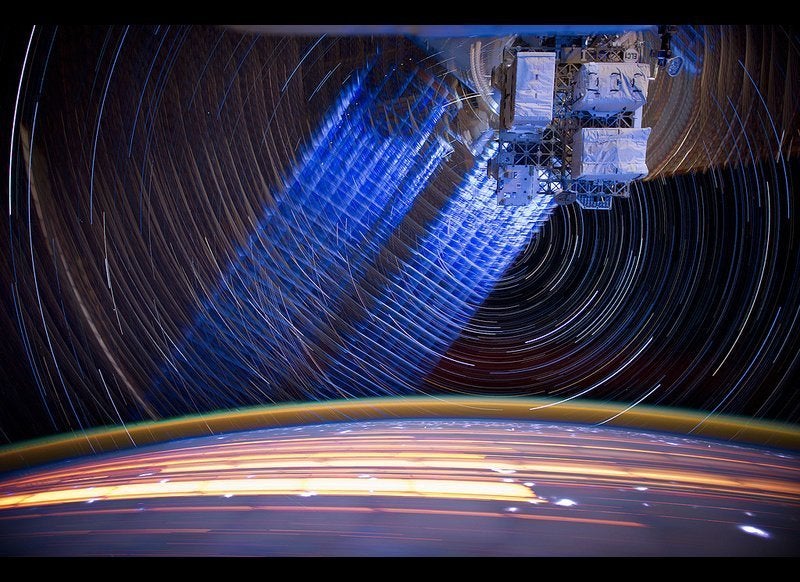
By: Rob Coppinger, SPACE.com Contributor
Published: 04/02/2013 01:31 PM EDT on SPACE.com
LONDON — A Swiss company has unveiled an ambitious plan to build a privately built robotic rocket plane by 2017 in order launch satellites into orbit.
The company Swiss Space Systems (S3) plans to loft the unmanned suborbital shuttle from the back of an Airbus A300 jetliner to serve as a commercial satellite launch platform. The Payerne, Switzerland-based firm unveiled the satellite launch concept on March 13 and is expected to reveal the supplier of its shuttle rocket engine in April.
"S3 aims to develop, build, certify and operate suborbital space shuttles dedicated to launching small satellites, enabling space access to be made more democratic thanks to an original system with launching costs up to four times less than at present," the company announced in a statement. "The first test launches will be carried out by the end of 2017."

An illustration of the Swiss Space Systems unmanned space plane SOAR space plane's upper stage rocket engine for launching small satellites into orbit.
S3 officials said they plan to build a mock up of the unmanned mini-shuttle by 2014, then open the a commercial spaceport in Payerne in 2015. The first flightworthy spacecraft prototype is slated to be built by in 2016, with the initial test flights following a year later. If all ges well, commercial satellite launches would begin in 2018. [Photos: Swiss Robotic Mini-Shuttle Concept Unveiled]
The unmanned satellite launches may be just the beginning, S3 officials said.
"Our first priority is the launch of small satellites until 2018," Gregoire Loretan, S3's head of communications, told SPACE.com in an email. "And the goal for S3 is to establish certification process and standards to help the development of manned flight afterwards."
A new rocket plane rises
According to S3's flight plan, the company plans to launch its robot rocket plane from an altitude of about 33,000 feet (10,000 meters). After separating from the carrier plane, the rocket plane will fire a liquid oxygen and kerosene rocket engine to reach an altitude of nearly 50 miles (80 kilometers).
S3 officials have dubbed the vehicle a space plane, though technically the rocket-powered craft will not fly high enough to cross the recognized the boundary of space, about 62 miles (100 km). But the 50-mile target altitude is high enough to launch a satellite into orbit. [Space Plane Evolution Explained (Infographic)]
At that height, the robotic shuttle will open its cargo bay doors to deploy a satellite equipped with its own rocket engine, a third stage, to launch the 550-pound (250 kilograms) satellite into an orbit about 434 miles (700 km) above Earth. The mini-shuttle should then glide back to Earth and land at its home spaceport.
The total development cost for the launch system is estimated to be about 200 million Swiss Francs, or $211 million. Another 50 million Francs ($53 million) will pay for a Swiss spaceport, S3 officials said.
"The overall budget is 250 millions [Swiss Francs], this includes one spaceport. A large part of this budget is already covered by private investors and our partners," Loretan said.
The S3 rocket plane will be able to launch small satellites, as well as tiny cubesats, he added. Loretan also states that the shuttle’s satellite dispenser is "adaptative," meaning S3 can mix the types of spacecrafts the vehicle will launch during a mission.
S3 already has four launch agreements with one of its partner organizations, Belgium's Von Karman Institute, a fluid dynamics research center. The cost per launch is predicted to be $10.5 million.
Loretan added that details of the satellite release procedure are still being developed.
"We are discussing with a robotic company for the opening of the payload bay and the satellite release mechanism. At the moment, the solution is not defined," he said.
Partners building on experience
S3 has teamed up with several industry partners for the suborbital rocket plane project. They include the Belgian aerospace engineering company Sonaca; the UK engineering firm Meggit; the Belgian technology firm Space Application Systems (SAS; Spain's Deimos Space aerospace company; French aerospace specialist Dassault Aviation; and Belgium’s Von Karman Institute.
"These partners, technical advisors and sponsors all contribute to our project, with technical support, material support, financial support, human resources and the heritage of already developed and certified technologies," Loretan said.

The Switzerland-based Swiss Space Systems announced plans to launch a privately built SOAR unmanned space plane from an Airbus A300 jetliner by 2017 for small satellite launches.
The Swiss watch manufacturer Breitlingis S3's main sponsor and has a historical association with spaceflight. A Breitling watch was worn in space by NASA Mercury 7 astronaut Scott Carpenter during his 1962 Aurora 7 orbital flight.
For the mini-shuttle, Deimos is working on guidance, navigation and control and mission analysis; Sonaca, the vehicle’s structures; Meggitt is providing the sensors; SAS, the software; and Dassault Aviation, the aviation systems.
Dassault officials said "the S3 project is directly derived" from its hypersonic reusable aircraft project VEHRA, which was designed to launch small satellites of up to 300kg into low-Earth orbit.
Video animations of a VEHRA space plane being launched by an Airbus airliner have been available online since at least 2007. In those simulations, the VEHRA craft are seen using a robotic arm to deploy payloads.
"We have been collaborating with Dassault since 2005," Loretan said. "S3 launching system concept is based on VEHRA's concept, but the shape, structure, propulsion engine, systems architecture , third stage development, mechanization and robotics, software and systems are all different."
Certification and landing site hurdles
While Switzerland is not a member of the European Union, the country is a member state of the European Aviation Safety Agency (EASA), the EU's version of the U.S. Federal Aviation Administration.
"We want to certify our launching systems, and we are already working in collaboration with the EASA rule makers for these new rules (we already took part to several workshops and meetings in Brussel)," Loretan explained. "This is a priority for our company to invest in the development of these rules."
Compared to the United States, continental Europe is a densely populated area. While the A300 could launch the S3 mini-shuttle from a site over the Atlantic Ocean or other unpopulated region, the rocket plane's glide range is much shorter than that of its carrier aircraft, so returning to continental Europe after a satellite launch may not be possible.
To solve that problem, S3 officials have reached out to the government of Morocco and Spaceport Malaysia as partners. The Swiss company is working with them to have safe launch areas.
"Morocco wants to build a spaceport in their country, and this is definitely an interesting location to have our first flights," Loretan said. "We will sign a [memorandum of understanding] with this country as we already did with Malaysia, with the same scope of collaboration. We want to operate [in Malaysia] by 2018, but we could also make flight tests over there earlier."
But before any S3 launches liftoff from Morocco or Malaysia, S3 will develop its $53 million spaceport at Payerne airport. S3 and its 25 employees are located in Payerne city, which is in a western area of Switzerland, about 30 miles east of France.
"We are already discussing this [spaceport] project with local and federal authorities, and we plan to pursue these discussions in the next couple of months," Loretan said.
Because of its large local populace, flights from Payerne would only be during civilian air traffic hours. Typically in Europe that is between 6 a.m. and midnight, Loretan added.
Follow us @Spacedotcom, Facebookand Google+. Original article on SPACE.com.
